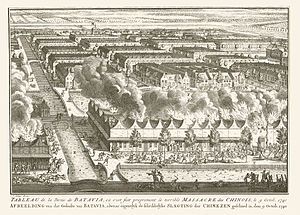
Back Sinofobie Afrikaans رهاب الصين Arabic Sinofobiya Azerbaijani চীনাভীতি Bengali/Bangla Sinofobia Spanish Sinofobia Basque چینیستیزی Persian Sinophobie French סינופוביה HE चीन-विरोधी भावना Hindi

Anti-Chinese sentiment (also referred to as Sinophobia) is the fear or dislike of Chinese people and/or Chinese culture.[1][2][3][4][5][6]
It is frequently directed at Chinese minorities which live outside Greater China and involves immigration, nationalism, political ideologies, disparity of wealth, the past tributary system of Imperial China, majority-minority relations, imperial legacies, and racism.[7][8][9][note 1]
A variety of popular cultural clichés and negative stereotypes of Chinese people have existed around the world since the twentieth century, and they are frequently conflated with a variety of popular cultural clichés and negative stereotypes of other Asian ethnic groups, known as the Yellow Peril.[12] Some individuals may harbor prejudice or hatred against Chinese people due to history, racism, modern politics, cultural differences, propaganda, or ingrained stereotypes.[12][13]
The COVID-19 pandemic led to resurgent Sinophobia, whose manifestations range from as subtle acts of discrimination such as microaggression and stigmatization, exclusion and shunning, to more overt forms, such as outright verbal abuse, slurs and name-calling, and sometimes physical violence.[14][15][16][17][18]
- ^ "Sinophobia is "Fear of or contempt for China, its people, or its culture" states The American Heritage Dictionary of the English Language, Online Edition. Retrieved July 12, 2012". Archived from the original on June 29, 2015. Retrieved July 13, 2012.
- ^ Macmillan dictionary. Retrieved July 7, 2022.
- ^ The Free Dictionary By Farlex. Retrieved July 7, 2022.
- ^ Collons Dictionary. Retrieved July 7, 2022.
- ^ hksspr (January 31, 2024). "Chinese-Indonesians Face Long Road to National Integration, Except During Elections". HKS Student Policy Review. Archived from the original on July 11, 2024. Retrieved July 11, 2024.
- ^ "Minority Rights - Chinese in the Philippines". Minority Rights. October 16, 2023. Archived from the original on July 6, 2024. Retrieved August 26, 2024.
- ^ Cite error: The named reference
Analysiswas invoked but never defined (see the help page). - ^ Aaron Langmaid. Chinese Aussie rules players suffer abuse, racism Archived April 5, 2023, at the Wayback Machine Herald Sun February 21, 2013
- ^ Cite error: The named reference
kazinwas invoked but never defined (see the help page). - ^ Chih-yu Shih; Prapin Manomaivibool; Reena Marwah (August 13, 2018). China Studies In South And Southeast Asia: Between Pro-china And Objectivism. World Scientific Publishing Company. p. 36.
- ^ 紀紅兵; 內幕出版社 (August 25, 2016). 《十九大不准奪權》: 反貪─清除野心家 (in Chinese). 內幕出版社. ISBN 978-1-68182-072-9. Archived from the original on August 26, 2024. Retrieved August 26, 2024.
... 第三點,作為獨立學者,與您分享下本人"反中不反華"的觀點。
- ^ a b William F. Wu, The Yellow Peril: Chinese Americans in American Fiction, 1850–1940, Archon Press, 1982.
- ^ "Conference Indorses Chinese Exclusion; Editor Poon Chu Says China Will Demand Entrance Some Day – A Please for the Japanese – Committee on Resolutions Commends Roosevelt's Position as Stated in His Message". The New York Times. December 9, 1905. p. 5. Archived from the original on July 26, 2018. Retrieved February 21, 2010.
- ^ Cheah, Charissa S. L.; Ren, Huiguang; Zong, Xiaoli; Wang, Cixin. "COVID-19 Racism and Chinese American Families' Mental Health: A Comparison between 2020 and 2021". International Journal of Environmental Research and Public Health. 20 (8). ISSN 1660-4601.
- ^ Tahmasbi, Fatemeh; Schild, Leonard; Ling, Chen; Blackburn, Jeremy; Stringhini, Gianluca; Zhang, Yang; Zannettou, Savvas (June 3, 2021). ""Go eat a bat, Chang!": On the Emergence of Sinophobic Behavior on Web Communities in the Face of COVID-19". Proceedings of the Web Conference 2021. WWW '21. New York, NY, USA: Association for Computing Machinery. pp. 1122–1133. doi:10.1145/3442381.3450024. ISBN 978-1-4503-8312-7.
- ^ Viladrich, Anahí (2021). "Sinophobic Stigma Going Viral: Addressing the Social Impact of COVID-19 in a Globalized World". American Journal of Public Health. 111 (5): 876–880. doi:10.2105/AJPH.2021.306201. ISSN 0090-0036. PMC 8034019. PMID 33734846.
- ^ Gao, Zhipeng (2022). "Sinophobia during the Covid-19 Pandemic: Identity, Belonging, and International Politics". Integrative Psychological & Behavioral Science. 56 (2): 472–490. doi:10.1007/s12124-021-09659-z. ISSN 1932-4502. PMC 8487805. PMID 34604946.
- ^ Sengul, Kurt (May 3, 2024). "The (Re)surgence of Sinophobia in the Australian Far-Right: Online Racism, Social Media, and the Weaponization of COVID-19". Journal of Intercultural Studies. 45 (3): 414–432. doi:10.1080/07256868.2024.2345624. ISSN 0725-6868.
Cite error: There are <ref group=note> tags on this page, but the references will not show without a {{reflist|group=note}} template (see the help page).